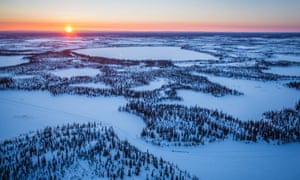Old Rocks
Diamond Member
Record-breaking temperatures 'have robbed the Arctic of its winter'
Record-breaking temperatures 'have robbed the Arctic of its winter'
Fort Yukon has recorded Alaska’s coldest ever temperatures but this winter temperatures have been much warmer than usual, leading to dangerously thin ice

A lack of snow in south central Alaska forced race organisers to move the Iditarod dog sled race north. Photograph: Loren Holmes/AP
Suzanne Goldenberg in Fort Yukon, Alaska
@suzyji
Tuesday 15 March 2016 13.48 EDTLast modified on Thursday 17 March 201608.27 EDT
Shares
4,477
Comments
1,048
Save for later
This year’s record-breaking temperatures have robbed the Arctic of its winter, sending snowmobilers plunging through thin ice into freezing rivers and forcing deliveries of snow to the starting line of Alaska’s legendary Iditarod dogsledding race.
Last month’s high temperatures – up to 16C (29F) above normal in some parts of the Arctic – flummoxed scientists, and are redefining life in the Arctic, especially for the indigenous people who live close to the land.
In Fort Yukon, an indigenous Gwich’in community eight miles inside the Arctic Circle, the freakishly warm weather is forcing people off the rivers that are their main transport corridors in the winter time.
“You can’t trust the ice,” said Ed Alexander, Yukon Flats centre coordinator for the University of Alaska at Fairbanks. “This is the warmest winter that we have ever seen up here. We have had less snow. We have had real thin ice. We have had an explosion of growth in the brush clogging up trails and that kind of thing. It makes everything dangerous.”
And so the heat continues.
Record-breaking temperatures 'have robbed the Arctic of its winter'
Fort Yukon has recorded Alaska’s coldest ever temperatures but this winter temperatures have been much warmer than usual, leading to dangerously thin ice

A lack of snow in south central Alaska forced race organisers to move the Iditarod dog sled race north. Photograph: Loren Holmes/AP
Suzanne Goldenberg in Fort Yukon, Alaska
@suzyji
Tuesday 15 March 2016 13.48 EDTLast modified on Thursday 17 March 201608.27 EDT
Shares
4,477
Comments
1,048
Save for later
This year’s record-breaking temperatures have robbed the Arctic of its winter, sending snowmobilers plunging through thin ice into freezing rivers and forcing deliveries of snow to the starting line of Alaska’s legendary Iditarod dogsledding race.
Last month’s high temperatures – up to 16C (29F) above normal in some parts of the Arctic – flummoxed scientists, and are redefining life in the Arctic, especially for the indigenous people who live close to the land.
In Fort Yukon, an indigenous Gwich’in community eight miles inside the Arctic Circle, the freakishly warm weather is forcing people off the rivers that are their main transport corridors in the winter time.
“You can’t trust the ice,” said Ed Alexander, Yukon Flats centre coordinator for the University of Alaska at Fairbanks. “This is the warmest winter that we have ever seen up here. We have had less snow. We have had real thin ice. We have had an explosion of growth in the brush clogging up trails and that kind of thing. It makes everything dangerous.”
And so the heat continues.
